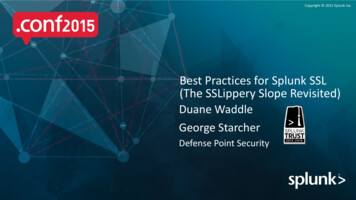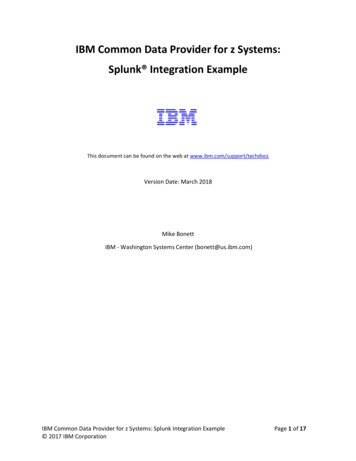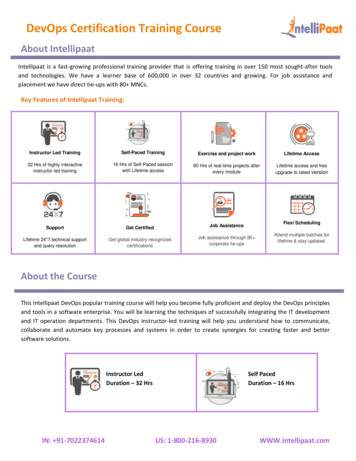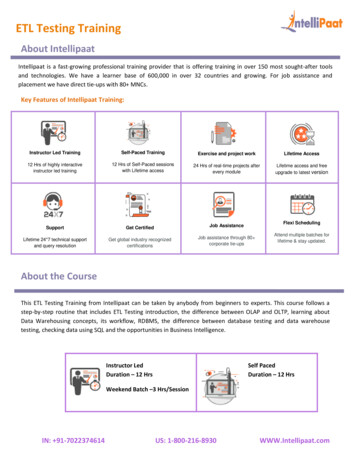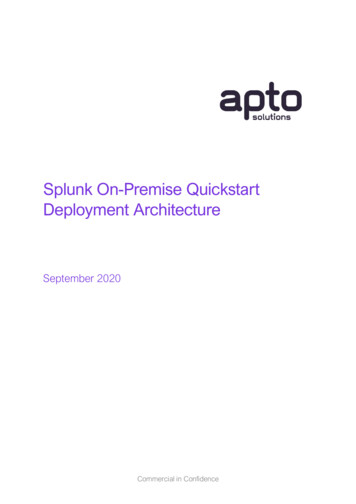
Transcription
About IntellipaatIntellipaat is a global online professional training provider. We areoffering some of the most updated, industry-designed certificationtraining programs in the domains of Big Data, Data Science & AI,Business Intelligence, Cloud, Blockchain, Database, Programming,Testing and 150 more technologies.We help professionals make the right career decisions, choose thetrainers with over a decade of industry experience, provide extensivehands-on projects, rigorously evaluate learner progress and offerindustry-recognized certifications. We also assist corporate clients toupskill their workforce and keep them in sync with the changingtechnology and digital landscape.www.intellipaat.com Copyright IntelliPaat. All rights reserved.
About The CourseThis is an Intellipaat masters’ program in Splunk tool that includesSplunk developer and Splunk administration training. As part of thisSplunk course, you will work on searching, sharing, saving Splunkresults, creating tags, generating reports and charts, installing andconfiguring Splunk, monitoring, scaling and indexing large volumesof searches and analyzing it using the Splunk tool.Exercise and projectworkInstructor Led Training26 Hrs of highlyinteractive instructor ledtrainingSelf-Paced Training26 Hrs of Self-Pacedsessions with LifetimeaccessSupportLifetime 24*7technical supportand query resolution40 Hrs of real-timeprojects after everymoduleLifetime AccessLifetime access andfree upgrade to latestversionJob AssistanceGet CertifiedGet global industryrecognizedcertificationsJob assistancethrough 80 corporate tie-upsFlexi SchedulingAttend multiplebatches for lifetime &stay updated.Why take this Course?Splunk is the most popular tool used for parsing huge volumes ofmachine-generated data and deriving valuable insights from it. ThisIntellipaat instructor-led and self-paced training in Splunk Developerand Splunk Administration is your passport to working in the Splunkdomain in order to gain a definitive edge when it comes todeploying Splunk in mission-critical applications in the real world inwww.intellipaat.com Copyright IntelliPaat. All rights reserved.
top MNCs and commanding big salaries in the process.www.intellipaat.com Copyright IntelliPaat. All rights reserved.
Course ContentSplunk DeveloperSplunk Administration1.Splunk Development Concepts1.Overview of Splunk2.Basic Searching2.Splunk Installation3.Using Fields in Searches3.Splunk Installation in Linux4.Saving and Scheduling Searches4.Distributed Management Console5.Creating Alerts5.Introduction to Splunk App6.Scheduled Reports6.Splunk Indexes and Users7.Tags and Event Types7.Splunk Configuration Files8.Creating and Using Macros8.Splunk Deployment Management9.Workflow9.Splunk Indexes10.Splunk Search Commands10.User Roles and Authentication11.Transforming Commands11.Splunk Administration Environment12.Reporting Commands12.Basic Production Environment13.Mapping and Single Value13.Splunk Search EngineCommands14.Various Splunk Input Methods14.Splunk Reports and Visualizations15.Splunk User and Index Management15.Analyzing, Calculating and16.Machine Data ParsingFormatting Results17.Search Scaling and Monitoring16.Correlating Events18.Splunk Cluster Implementation17.Enriching Data with Lookups18.Creating Reports and Dashboards19.Getting Started with Parsing20.Using Pivot21.Common Information Model (CIM)Add-Onwww.intellipaat.com Copyright IntelliPaat. All rights reserved.
Splunk Development Concepts Introduction to Splunk and Splunk developer roles and responsibilitiesBasic Searching Writing Splunk query for search Auto-complete to build a search, time range, refine search, working with events Identifying the contents of search and controlling a search jobUsing Fields in Searches What is a Field and how to use Fields in search Deploying Fields Sidebar and Field Extractor for REGEX field extraction and delimitingField Extraction using FXSaving and Scheduling Searches Writing Splunk query for search, sharing, saving, scheduling and exporting search resultsCreating Alerts How to create alerts, understanding alerts and viewing fired alerts.Scheduled Reports Describe and configure scheduled reportsTags and Event Types Introduction to Tags in Splunk Deploying Tags for Splunk search Understanding event types and utility and generating and implementing event types insearchCreating and Using Macros What is a Macro and what are variables and arguments in Macroswww.intellipaat.com Copyright IntelliPaat. All rights reserved.
Workflow Creating get, post and search workflow actionsSplunk Search Commands Studying the search command and the general search practices What is a search pipeline How to specify indexes in search Highlighting the syntax and deploying the various search commands like fields, tables,sort, rename, rex and erexTransforming Commands Using top, rare and stats commandsReporting Commands Using following commands and their functions: addcoltotals, addtotals,top, rare andstatsMapping and Single Value Commands IPlocation, geostats, geom and addtotals commandsSplunk Reports and Visualizations Explore the available visualizations Create charts and time charts Omit null values and format resultsAnalyzing, Calculating and FormattingResults Calculating and analyzing resultswww.intellipaat.com Copyright IntelliPaat. All rights reserved.
Value conversion, roundoff and format values Using the eval command Conditional statements and filtering calculated search resultsCorrelating Events How to search the transactions Creating report on transactions Grouping events using time and fields and comparing transactions with statsEnriching Data with Lookups Learning data lookups Examples and lookup tables Defining and configuring automatic lookups and deploying lookups in reports andsearchesCreating Reports and Dashboards Creating search charts, reports and dashboards Editing reports and dashboards and adding reports to dashboardsGetting Started with Parsing Working with raw data for data extraction, transformation, parsing and previewUsing Pivot Describe pivot Relationship between data model and pivot Select a data model object Create a pivot report Create in stant pivot from a search and add a pivot report to dashboardwww.intellipaat.com Copyright IntelliPaat. All rights reserved.
Common Information Model (CIM) Add-On What is a Splunk CIM and using the CIM Add-On to normalize dataOverview of Splunk Introduction to the architecture of Splunk Various server settings, how to set up alerts Various types of licenses Important features of Splunk tool The requirements of hardware and conditions needed for installation of SplunkSplunk Installation How to install and configure Splunk The creation of index Standalone server’s input configuration The preferences for search Linux environment Splunk installation and the administering and architecting of SplunkSplunk Installation in Linux How to install Splunk in the Linux environment The conditions needed for Splunk and configuring Splunk in the Linux environmentDistributed Management Console Introducing Splunk distributed management console Indexing of clusters How to deploy distributed search in Splunk environment Forwarder management, user authentication and access controlwww.intellipaat.com Copyright IntelliPaat. All rights reserved.
Introduction to Splunk App Introduction to the Splunk app How to develop Splunk apps, Splunk app management, Splunk app add-ons Using Splunk-base for installation and deletion of apps Different app permissions and implementation and how to use the Splunk app andapps on forwarderSplunk Indexes and Users Details of the index time configuration file and the search time configuration fileSplunk Configuration Files Understanding of Index time and search time configuration filesin Splunk Forwarder installation Input and output configuration Universal Forwarder management and Splunk Universal Forwarder highlightsSplunk Deployment Management Implementing the Splunk tool Deploying it on the server Splunk environment setup and Splunk client group deploymentSplunk Indexes Understanding the Splunk Indexes The default Splunk Indexes Segregating the Splunk Indexes Learning Splunk Buckets and Bucket Classification Estimating Index storage and creating new Indexwww.intellipaat.com Copyright IntelliPaat. All rights reserved.
User Roles and Authentication Understanding the concept of role inheritance Splunk authentications, native authentications and LDAP authenticationsSplunk Administration Environment Splunk installation, configuration Data inputs App management Splunk important concepts Parsing machine-generated data Search indexer and forwarderBasic Production Environment Introduction to Splunk Configuration Files Universal Forwarder, Forwarder Management, data management, troubleshooting andmonitoringSplunk Search Engine Converting machine-generated data into operational intelligence Setting up the dashboard, reports and charts and integrating Search Head Clusteringand Indexer ClusteringVarious Splunk Input Methods Understanding the input methods Deploying scripted, Windows and network and agentless input types and fine-tuningthem allwww.intellipaat.com Copyright IntelliPaat. All rights reserved.
Splunk User and Index Management Splunk user authentication and job role assignment and learning to manage, monitorand optimize Splunk IndexesMachine Data Parsing Understanding parsing of machine-generated data Manipulation of raw data Previewing and parsing Data field extraction and comparing single-line and multi-line eventsSearch Scaling and Monitoring Distributed search concepts Improving search performance Large-scale deployment and overcoming execution hurdles and working with SplunkDistributed Management Console for monitoring the entire operationSplunk Cluster Implementation Cluster indexing Configuring individual nodes Configuring the cluster behavior, index and search behavior Setting node type to handle different aspects of cluster like master node, peer nodeand search headwww.intellipaat.com Copyright IntelliPaat. All rights reserved.
Project WorksProject 1 : Creating an Employee Database of a CompanyIndustry : GeneralProblem Statement : How to build a Splunk dashboard where employee details are readilyavailableTopics : In this project, you will create a text file of employee data with details like full name, salary,designation, ID and so on. You will index the data based on various parameters, use various Splunkcommands for evaluating and extracting the information. Finally, you will create a dashboard andadd various reports to it.Highlights : Splunk search and index commands Extracting field in search and saving results Editing event types and adding tagsProject 2 : – Building an Organizational Dashboard with SplunkIndustry : E-commerceProblem Statement : How to analyze website traffic and gather insightsTopics : In this project, you will build an analytics dashboard for a website and create alerts forvarious conditions. You will capture access logs of the web server and the sample logs and thenthe sample are uploaded. You will analyze the top ten users, the average time spent, peak responsetime of the website, the top ten errors and error code description. You will also createa Splunk dashboard for reporting and analyzing.www.intellipaat.com Copyright IntelliPaat. All rights reserved.
Highlights : Creating bar and line charts Sending alerts for various conditions Providing admin rights for dashboardProject 3 :– Field Extraction in SplunkIndustry : GeneralProblem Statement :How to extract the fields from event data in SplunkTopics : In this project, you will learn to extract fields from events using the Splunk field extractiontechnique. You will gain knowledge in the basics of field extractions, understand the use of thefield extractor, the field extraction page in Splunk web and field extract configuration in files. Youwill learn the regular expression and delimiters method of field extraction. Upon the completionof the project, you will gain expertise in building Splunk dashboard and use the extracted fieldsdata in it to create rich visualizations in an enterprise setup.Highlights : Field extraction using delimiter method Delimit field extracts using FX Extracting fields with the search commandwww.intellipaat.com Copyright IntelliPaat. All rights reserved.
Job Assistance ProgramIntellipaat is offering job assistance to all the learners who have completed the training. Youshould get a minimum of 60% marks in the qualifying exam to avail job assistance.Intellipaat has exclusive tie-ups with over 80 MNCs for placements.Successfully finish the trainingGet your resume updatedStart receiving interview callsIntellipaat Alumni Working in Top CompaniesRahul SinghSplunk Developer at Mindfire SolutionsThis Intellipaat Splunk Training and Certification course is all you will need towork as a machine-data analyst who analyses machine-generated data toconvert it into operational intelligence.Chandra Sekhar MeruguSenior System EngineerThanks to the entire Intellipaat team for quick response. I am more than happyto rank your service a 10 out of 10. You made it really worthwhile for me.Arpita KhandelwalSenior Threat Analysis Engineer at Hexaware TechnologiesFirst, let me thank Intellipaat for having created such a wonderful Splunk onlinetraining course. The level of attention to detail and the manner in which thecomplex concepts have been explained in the Splunk course materials are praiseworthy.More Customer Reviewswww.intellipaat.com Copyright IntelliPaat. All rights reserved.
Our Clients 80 CorporatesFrequently Asked QuestionsQ 1. What is the criterion for availing the Intellipaat job assistance program?Ans. All Intellipaat learners who have successfully completed the training post April 2017 aredirectly eligible for the Intellipaat job assistance program.Q 2. Which are the companies that I can get placed in?Ans. We have exclusive tie-ups with MNCs like Ericsson, Cisco, Cognizant, Sony, Mu Sigma,Saint-Gobain, Standard Chartered, TCS, Genpact, Hexaware, and more. So you have theopportunity to get placed in these top global companies.Q 3. Do I need to have prior industry experience for getting an interview call?Ans. There is no need to have any prior industry experience for getting an interview call. In fact,the successful completion of the Intellipaat certification training is equivalent to six months ofindustry experience. This is definitely an added advantage when you are attending an interview.Q 4. If I don’t get a job in the first attempt, can I get another chance?Ans. Definitely, yes. Your resume will be in our database and we will circulate it to our MNCpartners until you get a job. So there is no upper limit to the number of job interviews you canattend.Q 5. Does Intellipaat guarantee a job through its job assistance program?Ans. Intellipaat does not guarantee any job through the job assistance program. However, wewill definitely offer you full assistance by circulating your resume among our affiliate partners.www.intellipaat.com Copyright IntelliPaat. All rights reserved.
Splunk developer and Splunk administration training. As part of this Splunk course, you will work on searching, sharing, saving Splunk results, creating tags, generating reports and charts, installing and configuring Splunk, monitoring, scaling and indexing large volumes of searches and analyzing it using the Splunk tool. Instructor Led Training





